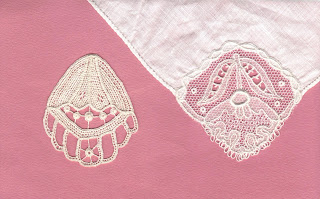 |
| Pam at last year's Heart & Hand Festival |
What was your first experience with lace? What initially drew you to this art form?
From childhood, I was attracted to lace because of its translucent and fairy-like qualities. I failed to get my grandmother to teach me her crochet lace skills, but taught myself shuttle tatting while in my teens. In my twenties I discovered that I was the namesake of Pamela Nottingham, one of the pioneers of the UK lacemaking revival, and bought her book on bobbin lacemaking, but didn’t start lace classes for another ten years, when I realized that “it was meant to be!”
 |
| Needle lace (left) and Carrickmacross, organdie applique on net (right) |
Are there different types of lace? What is special about the type of lace you make?Depending on how it is defined, there are hundreds of types of lace, grouped for convenience by their method of construction. Some are made with a single continuous thread, looped as in knitting or crochet, or knotted as in tatting or filet. Others are based on embroidery stitches, either applied to woven fabric or net, as in Hardanger and tambour, or built up from rows of buttonhole stitches, as in true needle lace. The bobbin or pillow laces are woven or plaited from multiple threads, wound on stick-like bobbins and hanging from pins placed in the pattern supported by a tightly stuffed pillow. Further sub-groups contain laces which combine two or more of these techniques, such as Battenberg or Ayrshire work, and of course, nearly all these types can be imitated by machine-made versions that look good enough – to the uninitiated! I am mainly attracted to some of the bobbin laces, because of their versatility, but I would need several more lifetimes to try them all, and new laces are being invented all the time, by teachers and designers. I also enjoy “dabbling” in other types of lace, especially Lier/Tambour from Belgium, Carrickmacross from Ireland, English “Hollie Point”/needle lace and still, occasionally, tatting!
Is lace making a dying art form? How can we ensure that the tradition of lace making survives?
Lacemaking as an economic activity/industry has all but died out, to be replaced by its role as a medium of artistic expression appropriate to our rapidly changing cultural scene. My interest in keeping it alive springs from my background in history, textiles and costume (for humans and dolls!) but I also like to explore new ways of using the techniques with non-traditional fibres, wire, beads etc. in contemporary designs and functions.
 |
| Lace making techniques used in new ways |
There are indications that many of the coming generation are interested in History as a means of interpreting our future, and if this interest extends to discovering the skills of traditional crafts and employing them to create the cultural objects of the future, lacemaking should survive along with the more obviously “practical” trades. The role of electronic communication will be crucial to this survival, enabling fibre artists from across the world to exchange ideas on dedicated chat sites, international and local guild websites, through educational initiatives with how-to videos, online courses with links to live teachers, downloadable documents, patterns and suppliers’ catalogues for ordering previously obscure materials with a few mouse clicks! Aspiring younger lacemakers used to search out the aged practitioners, to make notes on the fine points of the craft before it and they, passed away; now the next generation can go to the aged lacemaker’s website or watch her manipulate threads tirelessly on Youtube, but will also be made very welcome at the many live craft guild meetings, shows and demonstrations.
I have ongoing projects to make a replica 19th c. Bedfordshire lace fall cap, to be worn with my historical interpreter’s costumes, and to make a full-size, rather than miniature fan leaf, to fit some antique bone fan sticks.





No comments:
Post a Comment